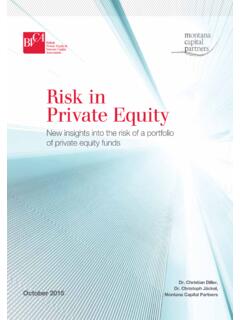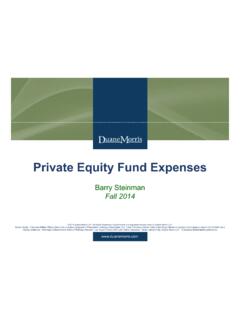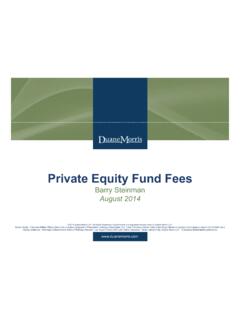Transcription of Private Equity Accounting Contents and Extract
1 Private EQUITYACCOUNTINGThe global guide for Private Equity firms and fund accountantsBy Mariya StefanovaTable of Contents & sample pagesBuy now: Private EQUITYACCOUNTINGBy Mariya Stefanova Table of Contents Foreword by Anthony Cecil, KPMG LLP & Angela Crawford-Ingle, Ambre Partners Limited1. Introduction to Private Equity for accountants2. Private Equity structures and types of funds3. Why Private Equity Accounting is different?4. The Limited Partnership Agreement (LPA) explained5. Fund lifecycle6. Initial, subsequent and final closings, rebalancing and equalisation7.
2 Drawdowns8. Partner transfers9. Investments10. Valuations,by David L. Larsen, Duff & Phelps LLC11. Expenses and income12. Management fee versus Priority Profit Share (PPS)13. DistributionsBuy now: 14. Carried interest15. Fund financial statements format and how they are different from otherentities financial statements16. More about allocationsby Gaurav Marwah, Augentius Fund Administration LLP17. Consolidationby Angela Crawford-Ingle, Ambre Partners Limited18. Performance measurement is it all about IRRs?by Alistair Hamilton, Inflexion Private Equity Partners LLP19.
3 Investor reporting - Accounting support for Investor Relationsby Monika Nachyla20. Private Equity Accounting an auditor s perspectiveby Nat Harper, KPMG LLP21. Some final topicsa. Accounting for other entities within the fund structureb. How different Accounting platforms support Private equityc. In-house vs. outsourced fund accountingPRIVATE EQUITYACCOUNTINGBy Mariya Stefanova Table of Contents Buy now: 3103 Why is Private Equity Accounting different?By Mariya StefanovaAccounting for a Private Equity fund (and the other entities within the fund structure described in Chapter 2) is quite unique not that Accounting rules do not apply, they certainly do, but due to the fact that when Accounting frameworks are defined, the standards-setters usually do not write them with Private Equity in mind (of course there are exceptions, such as US GAAP11)
4 , and therefore some modifications to these rules and accounts formats are required in order for those accounts to be useful to their user mostly the investors. So, what is so unique about Private Equity Accounting that sets it apart from Accounting for entities of other types of investment vehicles and other industries? If you are new to Private Equity you will be able to answer that question by the end of this a nutshell, there are six major differentiators that separate Private Equity Accounting from Accounting for entities of other industries and other types of investment vehicles:The legal form a limited partnership with its different investor classes (LPs, GP and FP) 1.
5 And the way that this legal form is used to cater for the specific needs of the asset fund terms laid down in the limited partnership agreement (LPA).2. The purpose and nature of the activities of the Private Equity The needs of the main users of the financial statements the investors and their 4. reporting unique Accounting framework used only in this asset class the investor-defined 5. 1 In US GAAP a separate set of rules applies the AICPA Audit and Accounting Guide for Investment Companies, where Accounting rules are put in the context of investment chapter discusses:The ways Private Equity Accounting is different from Accounting for other zinvestment typesFactors contributing to the uniqueness of Private Equity Accounting , including.
6 ZThe preferred legal form (limited partnership and equivalents) and its specific allocations and allocation rulesLimited partnership agreement (LPA) Fund purpose, activities and structure Investors needs for financial reporting information Accounting frameworks and the investor-defined Accounting framework (LPA GAAP)Buy now: 32 Section I: Chapter 3accounting framework , also called LPA GAAP (Generally Accepted Accounting Principles) which is still used in certain jurisdictions (for example, the UK).The combination of these five factors, which are explained below one by one, makes Private Equity Accounting unique and difficult to understand, at least at first, by accountants from outside of the asset class.
7 This guide sets out to give the reader, in a systematic and hopefully comprehensive way, an insight into the mechanics of Private Equity explained in Chapters 1 and 2, a limited partnership (fund for joint account or other similar forms) is the preferred legal form for Private Equity funds. The ways in which that legal form is used to cater for the needs of the asset class, particularly the arrangement of the different classes of partners (limited partners (LP), general partner(s) (GP), founder partner (FP)), with different rights and responsibilities, are the framework for the Accounting and reporting that dictates the layout of the accounts, how the information is recorded and what level of analysis is first thing to bear in mind is that, in a limited partnership, investors (LPs)
8 Have an interest in the partnership. The same logic applies to a corporate form, but instead of interest in a partnership, investors have shares. There are other types of partner. A GP acts in its capacity as a GP with its responsibility to manage the fund, but it can also be an LP/investor. In a UK partnership there may be an FP, which is basically a carried interest partner (CIP) that can act in its capacity as such, but also, similar to the GP, may act in its capacity as an LP/investor; these different entities in the fund can be referred to as classes of partners (but sometimes I may refer to them as classes of investors ).
9 A basic premise for the preparation and presentation of the partnership s financial statements is to reflect the interest of each class of partner (or shareholders in a corporate form) in the net assets of the partnership at each reporting date, or in other words the share of each class of partners in all the partnership s assets, liabilities, income and expenses (net income) and gains or losses. The aim is also to present the return (understand the total profit and loss (P&L)) by partner class, as well as by individual non-managing partner/investor.
10 Therefore a fund s accountant needs to be able to track transactions and identify balances at the partner level, which is achieved by recording the transactions at that level. All the partners LPs, GP and FP have certain functions, rights and responsibilities within the structure, as explained in more detail in Chapter 2. Following that logic, when recording transactions that stem from those functions, rights and responsibilities, these transactions should be allocated to each partner; this then allows for individual reporting on each partner in terms of its share in the assets, liabilities, income, expenses and gains or losses which is ultimately their share in the net assets or net asset value (NAV).









